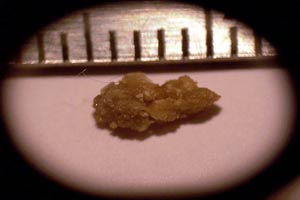Percutaneous renal endoscopic kidney (Part 1)
Endoscopic surgery allows kidney stones to be cut through the skin, one of the most new and modern methods of treating kidney stones today. In Vietnam, only two hospitals in the North and Central can achieve this method, namely Viet Duc Hospital and Viet Phap Hospital. The recent VTV on VTV has helped the audience to witness a laparoscopic surgery of percutaneous kidney stones and information related to this disease.
Kidneys excrete urine. In the urine there are many crystals, when urine is excessively concentrated, it creates kidney stones. Kidney stones cause a lot of pain as they pass through the urinary tract. According to calculations by some professors and doctors of urology and kidney in Vietnam, there are still 80% of urinary stones patients treated by classical open surgery method - method of causing multiple seizures and changes Postoperative conditions such as bleeding, infections, especially cases of urine leakage through the incision due to ureter obstruction.
At Viet Phap Hospital, VTV has installed right-of-way cameras at the operating room so that the audience can follow the surgery process. In the operating room, Dr. Nguyen Ngoc Tho is the one in charge of anesthesia in the operating theater. He was also the one who explained the whole operation process, helping the audience to follow.

Gravel more than 2.5cm should apply the method of skin endoscopic lithotripsy (Photo: Sammich)
The patient who is operated on is a Vietnamese male patient, 45 years old. This patient had suffered from lumbar pain for a long time, but recently went to see a doctor. Through examination and testing, doctors found a large gravel, on the right and 30mm in diameter.
To perform the surgical crew, there are 8 people, divided into 2 main crews which are surgical crews and anesthesia crews. Before the operation, the patient is allowed to do all tests, and necessary for the operation. Patients are also instructed about tools and medicines to ensure patients are less likely to suffer pain. Another important thing is that before surgery, the patient must fast for at least 6 hours before surgery.
While patients undergo surgery to maintain the specifications of circulatory respiration, kidney and liver parameters to ensure within normal limits. On the other hand, patients must ensure deep sleep and no pain.
At the S1 studio, there was also an exchange with two experts on kidney stones, namely: Master - Dr. Vu Nguyen Khai Ca - Head of urology department of Viet Duc hospital. And Dr. Le Si Trung - head of the Vietnamese French hospital urology department. Experts have raised "startling" numbers about kidney stones, which explain why the disease is causing it.
The cause to the illness
There are three main causes of kidney stones:
- Due to urinary infections.
- Due to metabolic disorders, kidney stones have calcium, phosphates and other factors due to this metabolic disorder that form stones.
- Due to congenital malformations of the urinary tract and stagnation of internal urine and stone formation.
Surgical methods
There are many treatments, but endoscopic surgery for percutaneous renal stones is less invasive and safe. Through this surgery, thanks to modern treatments, they will help them less pain, no stones, and quickly recover. Instead of being hospitalized for several weeks after surgery to remove kidney stones, patients can go home after 3-4 days if they receive percutaneous renal endoscopic lithotripsy, 1-2 days if they have ureteroscopy, even 1 / 2 days if the stone is outside the body.
Dr. Khai Ca said: In order to implement this method, patients must undergo 2 stages in a period of 60 - 90 minutes. The first stage is to create a tunnel into the kidney, using a device to heat the tunnel. After the sugar is wide enough, put the endoscope into the kidney and proceed with the second stage to spread the stone.
Advantages of method of skin endoscopic lithotripsy:
With modern technical conditions, patients are entitled to a less invasive surgery, ie there will be no longer incision at the waist, short hospital stay, better patient pain and the patient will be quick return to normal life. Open surgery is available when the patient is hospitalized for 1 month, but with this method, the patient must be hospitalized for at least 1 week.
And another advantage is that kidney function is retained. If the kidney stones have to be removed by adding a couple of kidneys for removal, the procedure alone permanently removes kidney function from 20-30%. Meanwhile, as a result of percutaneous renal endoscopy, these scientific studies have confirmed and demonstrated that the percentage of kidney function lost due to surgery is less than 3%.
However, there are also patients who are contraindicated to use this method, which are people with cardiovascular and coronary problems. In addition, patients with coagulopathy, obese patients are also contraindicated.
(There's more…)
Thuy Uyen (General)
- 10 symptoms of kidney failure
- Renal dialysis device automatically saves nearly 700 billion VND / year
- Things to know about cutaneous kidney stones
- Necklace with optical capsules
- Canada developed wireless endoscopic capsule technology
- What if people live with only one kidney until the end of their lives?
- New measures to treat kidney cancer
- Renal failure can cause heart damage
- All you need to know about kidney stones
- New hope for kidney failure
- People with kidney disease do not use effervescent tablets
- Kidney disorders at an early age have long-term effects
 Green tea cleans teeth better than mouthwash?
Green tea cleans teeth better than mouthwash? Death kiss: This is why you should not let anyone kiss your baby's lips
Death kiss: This is why you should not let anyone kiss your baby's lips What is salmonellosis?
What is salmonellosis? Caution should be exercised when using aloe vera through eating and drinking
Caution should be exercised when using aloe vera through eating and drinking